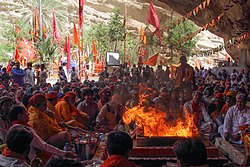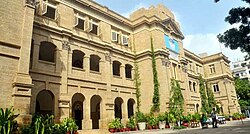Religions of Pakistan
| Religion in Pakistan | ||||
|---|---|---|---|---|
| Religion | Percent | |||
| Sunni Islam | 80% | |||
| Shia Islam | 15% | |||
| Hinduism | 2.1% | |||
| Christianity | 1.3% | |||
| Ahmadiyya | 0.2% | |||
| Others | 0.3% | |||

Religions of Pakistan have diverse beliefs and practices. As of 2024, Islam is the major and official religion in Pakistan. More than 90% of the people follow Islam. 80% are Sunni and <20% Shia muslims. Second largest religion in Pakistan is Hinduism. Between 2% and 4% are Hindus. At third is Christianity (Mostly Catholic and Protestant) followed by 1.6% of the total population.[1][2][3]
The Constitution of Pakistan gives freedom of religion for individuals of different faiths and sects. Other religions followed in Pakistan include Christianity, Sikhism, Zoroastrianism, Baha'i Faith, Ahmadiyya, Buddhism, Judaism and others.[4]
Christianity
Christians are the largest minority group in Pakistan. They live all over the country. Pakistani Christians belong to many ethnic groups and speak many languages. There are many different churches, and many different types of churches, in most cities in Pakistan.
Although Pakistani Christians do not only do one type of job, they have often done a lot of work in areas like health care, education, railways and the police force. They are also starting to do a lot of work in the civil and defence services.
Hinduism
Hindus are the second biggest minority in Pakistan.
These are people (and children of people) who followed the Hindu religion during the days when Pakistan and India were together. In those days, they were part of the lowest caste. They were called "untouchable," and had to do work that no one else would do. In a "caste system," there are different groups of people who are thought of as more or less important than each other. People would become a member of their caste when they were born, because their parents were part of that group. The lowest caste was thought of as the least important of all.
In Pakistan today, the law says that people are not allowed to treat this group badly. But people still do treat them badly, and make them do jobs that do not pay much money. Now some of these low-caste people are going to school and getting better jobs.
The Hindus of Pakistan are mostly found in Sindh, where they do a lot of farming. In the larger cities (like the city of Karachi), Hindus do a lot of buying and selling. They celebrate the Hindu holy days with all their traditional colour.
Ahmadiyya
The Ahmadis follow the things Mirza Ghulam Ahmad taught at the end of the 1800s. Their doctrine (religious beliefs) is very close to Islam on most points. However, the Ahmadis do not believe that Mohammad was God's last Prophet.
The Ahmadis do not call themselves non-Muslim. Only in the 1973 Constitution of Pakistan written by Zulfiqar Ali Bhutto after the secession of East Pakistan they were declared non-Muslim.
Ahmadis are mainly of Punjabi origin (from the Punjab area of India and Pakistan). They do all kinds of Humanitarian work not only in Pakistan, but all over the world.
Zoroastrianism
The Parsis or Zoroastrians are a very small minority who live mostly in Pakistan's larger cities. Almost all of them work in business. Some of Pakistan's most successful shipping businessmen are Parsis. The richer members of this community are well-known for their philanthropic activities (giving money to people or organizations, with the goal of helping them or doing good).
Buddhism
There are very few Buddhists in Pakistan. However, their ancestors' culture made a difference in Pakistan. Many ancient Buddhist temples, schools, and cities have been found by archaeologists in Pakistan.
Religions Of Pakistan Media
The Faisal Mosque in Islamabad, which is the largest mosque of Pakistan and is also one of the largest in the world, was built by King Faisal of Saudi Arabia.
Shri Hinglaj Mata temple shakti peetha is the largest Hindu pilgrimage centre in Pakistan. The annual Hinglaj Yathra is attended by more than 250,000 people.
Gurdwara Janam Asthan, the birthplace of the founder of Sikhism in Nankana Sahib
A Jain Temple at Sirkap, part of the Indo-Greek kingdom, near modern-day Taxila, Punjab, Pakistan
References
- ↑ "Pakistan - Islam, Hinduism, Sikhism | Britannica". www.britannica.com. Retrieved 20 December 2023.
- ↑ Jacobsen, Douglas (21 March 2011). The World's Christians: Who they are, Where they are, and How they got there. John Wiley & Sons. ISBN 978-1-4443-9729-1.
- ↑ "Hindu Population (PK) – Pakistan Hindu Council". Pakistan Hindu Council. 15 March 2018. Archived from the original on 15 March 2018. Retrieved 20 December 2023.
- ↑ Khan, Iftikhar A. (28 May 2018). "Number of non-Muslim voters in Pakistan shows rise of over 30pc". DAWN.COM. Retrieved 20 December 2023.











